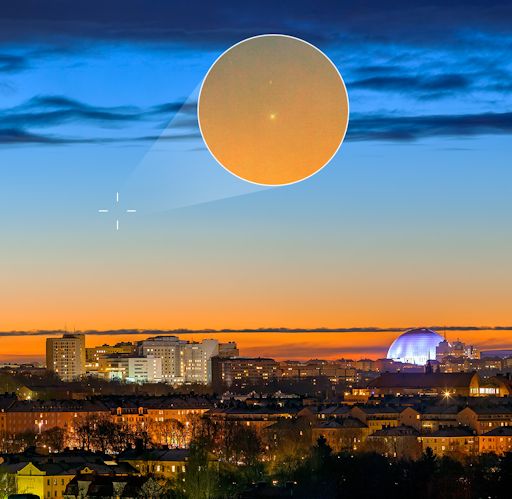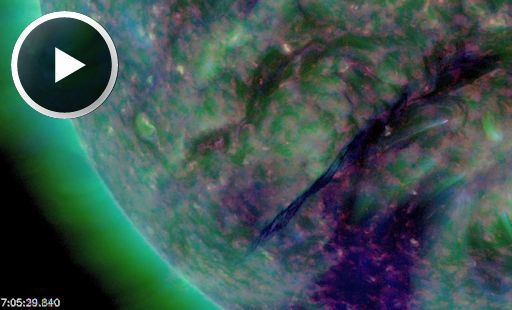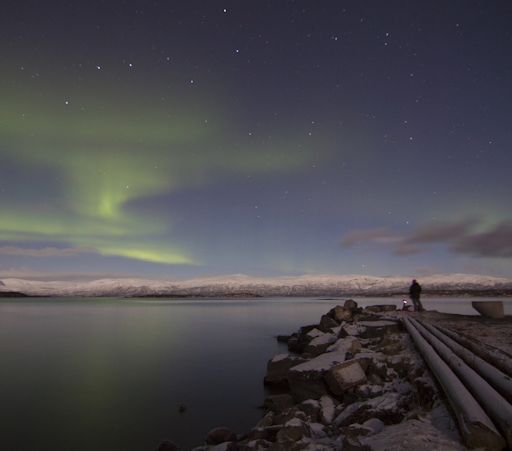Marianne's Heaven On Earth Aurora Chaser Tours Chasethelighttours.co.uk invites you to join them in their quest to find and photograph the Aurora Borealis. Experience the winter wonderland in the Tromsø Area. | | | TRANSCONTINENTAL SPACE WEATHER BALLOON UPDATE: The payloads of two space weather balloons launched on Nov. 21st from California and New Hampshire have been recovered--one from a desert wash in Death Valley National Park, the other from the top of an oak tree in Maine. Now the data analysis begins. Updates may be found on the Facebook page of Earth to Sky Calculus. SUNRISE COMET CATALINA: Discovered in 2013 by the Catalina Sky Survey, Comet Catalina (C/2013 US10) is making a one-time trip through the inner solar system. It swung around the sun on Nov. 15th and is now emerging in the dawn skies of the northern hemisphere. Peter Rosén photographed the comet in the morning sky of Stockholm, Sweden, on Nov. 23rd: 
"I woke up very early this morning to catch a first glimpse of comet Catalina," says Rosén. "While I waited for the comet to appear in the sunrise twilight, I spent my time observing Venus and Jupiter. As so often happens in Stockholm, the clouds rolled in and started covering the sky. I thought about giving up, but I noticed that there was still a strip of clear sky at the eastern horizon. Patience payed off and Comet Catalina even showed a thin tail at less than 3° above the horizon." Technically, Comet Catalina is a 6th magnitude object visible to the unaided eye. In practice, morning twilight overwhelms the comet's faint glow. You need a telescope to see it. "The inset is shot with a Canon Eos5D through my WilliamOptics FLT-110 at prime focus," says Rosén. Sky maps and observing tips are available from Sky & Telescope. This is Comet Catalina's first visit to the inner solar system--and its last. The comet's close encounter with the sun in mid-November has placed it on a slingshot trajectory toward interstellar space. It will become easier to see in the weeks ahead as it recedes from the sun, possibly brightening to 5th magnitude in December. A date of special interest is Dec. 7th when the comet pairs up with the planet Venus and the waning crescent Moon in the early morning sky. Catalina will be about 4o degrees away from the Venus-Moon combo. Stay tuned for more information about that, and meanwhile browse the realtime comet gallery for more sightings. Realtime Comet Photo Gallery FILAMENT ERUPTION PROBABLY MISSES EARTH: Yesterday, Nov. 22nd, a dark filament of magnetism erupted away from the sun's southeastern quadrant. NASA's Solar Dynamics Observatory recorded the blast: 
SOHO has observed a faint coronal mass ejection (CME) emerging from the blast site: movie. NOAA forecasters are still computing a storm track for the CME. At first glance, however, it appears to be moving well off of the sun-Earth line. This eruption will probably miss our planet. Solar flare alerts: text or voice Realtime Space Weather Photo Gallery AURORAS, FOR NO PARTICULAR REASON: Nov. 21st was a day of quiet space weather. There were no intense solar flares, no CMEs, and no geomagnetic storms. The auroras appeared anyway. Liselotte Kahns saw them over Sweden's Abisko National Park: 
"Despite the extremely low level of solar activity, Abisko's clear sky demonstrated a nice aurora display tonight," says Kahns. "[It's] a good illustration of why this place is rated as one of the best places on Earth to see auroras." Indeed, it is not unusual for auroras to appear over Abisko even when the forecast calls for no magnetic activity. Aurora tour guides and photographers naturally gravitate toward the Park because of its frequently-green skies. The reason is Abisko's location beneath Earth's persistent auroral oval. A gentle rain of solar wind electrons, guided to Earth by our planet's curved magnetic field, creates a polar ring of Northern Lights that intersects the latitude of Abisko, more often than not. Browse the realtime gallery for more sightings: Realtime Aurora Photo Gallery
Realtime Noctilucent Cloud Photo Gallery
Realtime Meteor Photo Gallery Every night, a network of NASA all-sky cameras scans the skies above the United States for meteoritic fireballs. Automated software maintained by NASA's Meteoroid Environment Office calculates their orbits, velocity, penetration depth in Earth's atmosphere and many other characteristics. Daily results are presented here on Spaceweather.com. On Nov. 23, 2015, the network reported 20 fireballs.
(14 sporadics, 4 Leonids, 2 Northern Taurids)  In this diagram of the inner solar system, all of the fireball orbits intersect at a single point--Earth. The orbits are color-coded by velocity, from slow (red) to fast (blue). [Larger image] [movies] Potentially Hazardous Asteroids ( PHAs) are space rocks larger than approximately 100m that can come closer to Earth than 0.05 AU. None of the known PHAs is on a collision course with our planet, although astronomers are finding new ones all the time. On November 23, 2015 there were potentially hazardous asteroids. Notes: LD means "Lunar Distance." 1 LD = 384,401 km, the distance between Earth and the Moon. 1 LD also equals 0.00256 AU. MAG is the visual magnitude of the asteroid on the date of closest approach. | | Cosmic Rays in the Atmosphere | | Situation Report -- Oct. 30, 2015 | Stratospheric Radiation (+37o N) | | Cosmic ray levels are elevated (+6.1% above the Space Age median). The trend is flat. Cosmic ray levels have increased +0% in the past month. | | Sept. 06: 4.14 uSv/hr (414 uRad/hr) | | Sept. 12: 4.09 uSv/hr (409 uRad/hr) | | Sept. 23: 4.12 uSv/hr (412 uRad/hr) | | Sept. 25: 4.16 uSv/hr (416 uRad/hr) | | Sept. 27: 4.13 uSv/hr (413 uRad/hr) | | Oct. 11: 4.02 uSv/hr (402 uRad/hr) | | Oct. 22: 4.11 uSv/hr (411 uRad/hr) | These measurements are based on regular space weather balloon flights: learn more. Approximately once a week, Spaceweather.com and the students of Earth to Sky Calculus fly "space weather balloons" to the stratosphere over California. These balloons are equipped with radiation sensors that detect cosmic rays, a surprisingly "down to Earth" form of space weather. Cosmic rays can seed clouds, trigger lightning, and penetrate commercial airplanes. Our measurements show that someone flying back and forth across the continental USA, just once, can absorb as much ionizing radiation as 2 to 5 dental X-rays. Here is the data from our latest flight, Oct. 22nd: 
Radiation levels peak at the entrance to the stratosphere in a broad region called the "Pfotzer Maximum." This peak is named after physicist George Pfotzer who discovered it using balloons and Geiger tubes in the 1930s. Radiation levels there are more than 80x sea level. Note that the bottom of the Pfotzer Maximim is near 55,000 ft. This means that some high-flying aircraft are not far from the zone of maximum radiation. Indeed, according to the Oct 22th measurements, a plane flying at 45,000 feet is exposed to 2.79 uSv/hr. At that rate, a passenger would absorb about one dental X-ray's worth of radiation in about 5 hours. The radiation sensors onboard our helium balloons detect X-rays and gamma-rays in the energy range 10 keV to 20 MeV. These energies span the range of medical X-ray machines and airport security scanners. | | The official U.S. government space weather bureau | | | The first place to look for information about sundogs, pillars, rainbows and related phenomena. | | | Researchers call it a "Hubble for the sun." SDO is the most advanced solar observatory ever. | | | 3D views of the sun from NASA's Solar and Terrestrial Relations Observatory | | | Realtime and archival images of the Sun from SOHO. | | | from the NOAA Space Environment Center | | | the underlying science of space weather | | 
